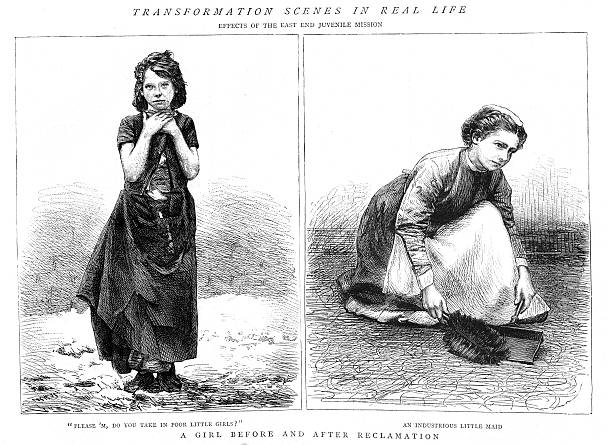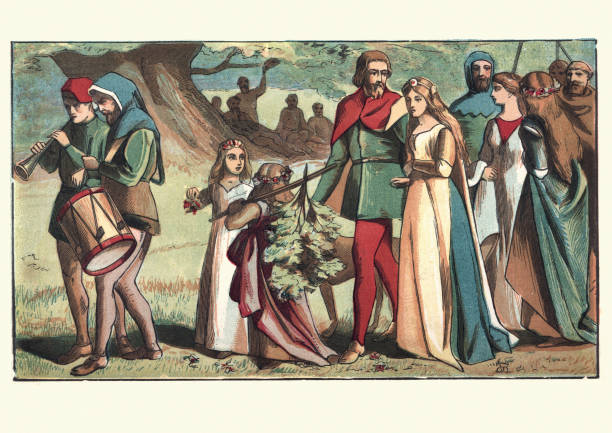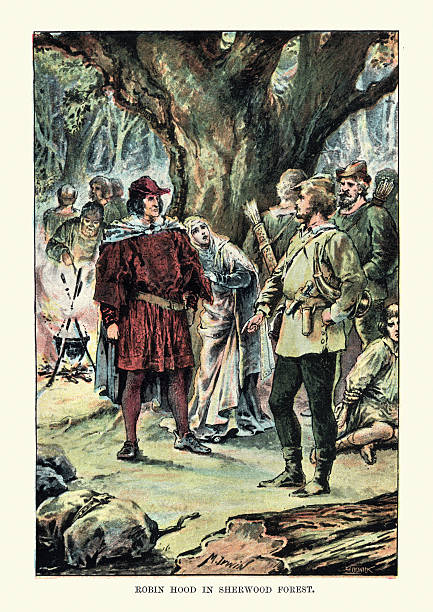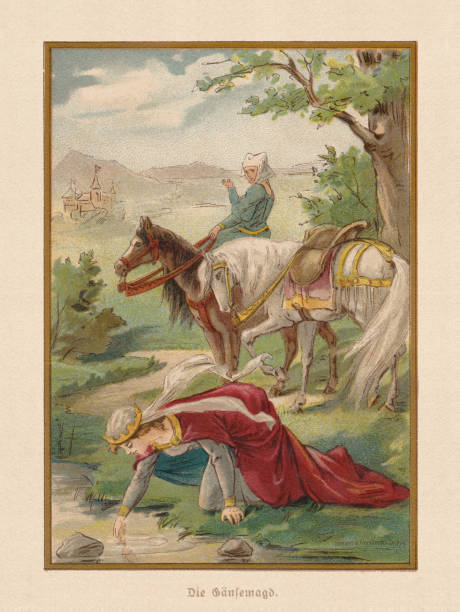
English Maid stock illustrations
Browse 110+ english maid stock illustrations and vector graphics available royalty-free, or search for victorian maid to find more great stock images and vector art.

Vintage engraving of Young Victorian servant girl, waitress, carrying a tea cup, 1880s, 19th Century
"Scanned directly from The Illustrated London News, dated 3 July 1852Vauxhall Pleasure Gardens. A new ballet 'Zelita, The Maid of Calabria', showing a performance in the new theatre at the Gardens by a French troupe."
Art Nouveau is an international style of art, architecture, and applied art, especially the decorative arts, known in different languages by different names: Jugendstil in German, Stile Liberty in Italian, Modernisme català in Catalan, etc. In English it is also known as the Modern Style. The style was most popular between 1890 and 1910 during the Belle Époque period that ended with the start of World War I in 1914. Original edition from my own archives Source : London Types - 1898 Sir William Nicholson – British artist, illustrator, and author, 1872-1949
Vintage colour lithograph from 1864 showing the capture of Joan of Arc in 1430. Saint Joan of Arc, nicknamed The Maid of Orléans is considered a national heroine of France and a Catholic saint. A peasant girl born in eastern France who claimed divine guidance, she led the French army to several important victories during the Hundred Years' War.
Vintage engraving from 1875 showing a poor young girl begging on the steert and as a maid after being saving from poverty.
“Sing a song of sixpence a pocket full of rye - Four and twenty blackbirds baked in a pie - When the pie was open’d the birds began to sing - Was that not a dainty dish to set before the King? - The King was in his counting house counting out his money - The queen was in the parlour eating bread and honey - The maid was in the garden hanging out the clothes - When up jumped a dickey bird and snapt off her nose.” The rhyme explains it all! From “Nursery Rhymes - Ridicula Rediviva” illustrated by J.E. Rogers, with chromolith printing by R. Clay Sons & Taylor and published in London in 1876 by Macmillan and Co.
vector icon workers, profession people uniform, cartoon vector illustration
From Punch's Almanack 1899.
Template of white blank restaurant chef uniform apron, realistic isolated on blue background. Restaurant kitchen staff white apron or pinafore. Vector illustration
Vintage engraving of the Wedding of Robin Hood and Maid Marion
Vintage engraving of Robin Hood in Sherwood Forest. Robin Hood is a heroic outlaw in English folklore who, according to legend, was a highly skilled archer and swordsman. Traditionally depicted as being dressed in Lincoln green, he is often portrayed as "robbing from the rich and giving to the poor.
An early 18th century yeoman sitting at a table with a plate of bread and pouring a tankard of ale while his servant or wife shows him a fine fat pheasant - presumably his dinner. His dog approves.
Child cleaning the room and organizing toys
An ill Victorian child being looked after by two women and a man. The man is probably the child’s father and the women could be its mother, grandmother, maid, nurse or housekeeper. The cup probably contains beef tea, or some other nourishing beverage. From “An Affair of Honour” by Alice Weber, illustrated by Emily J Harding, published by Griffith Farran & Co, London, in 1892.
Vector black and white crossword in English, education game for children. Maid and home furnishings
Whatever he said or did, it offended the housemaid - and he received a slapped cheek for his trouble! From “Stage-Land: Curious Habits and Customs of its Inhabitants” described by Jerome K Jerome with drawings by J Bernard Partridge. Published by Chatto & Windus, London, in 1890. The book is an entertaining account of the types of characters to be found upon the theatre stage.
Entering a Victorian boarding school boy’s study bedroom, especially when he has a passion for natural history, can be fraught with danger.
Vintage engraving showing a 18th century scene of drinking and over eating
A row of illustrated Victorian dolls - soldier, maid, sailor and smart lady - from “At Home”, illustrated by J.G. Sowerby and decorated by Thomas Crane. Printed and published by Marcus Ward & Co. in 1881.
Maid and postman from "On The Western Circuit" from the historic pre-1900 book "The English Illustrated Magazine 1891-1892". Imprint and cover as release.
The Goose Girl (German: Die Gänsemagd). The disobedient maid refuses the princess's service. European fairy tale, first translated into English by Edgar Taylor, written down by Jacob and Wilhelm Grimm. Chromolithograph after a drawing by Thekla Brauer, published in 1898.
vector icon workers, profession people uniform, cartoon vector illustration
Illustration from 19th century.
Two young 19th century girls hanging out ribbons to dry on a washing line. Blowing in the wind, the ribbons spell the word ‘Index’. From “Little Folks - A Magazine for the Young“. Published by Cassell & Company Limited, London, Paris & Melbourne, 1896.
A lIttle Victorian girl holding a cat while she is sitting at the tea table, to the evident horror of the parlour maid! From “An Affair of Honour” by Alice Weber, illustrated by Emily J Harding, published by Griffith Farran & Co, London, in 1892.
A cheeky Victorian housemaid flirting with the footman and tickling him with her feather duster. Perhaps she hopes he will marry her! From “Stage-Land: Curious Habits and Customs of its Inhabitants” described by Jerome K Jerome with drawings by J Bernard Partridge. Published by Chatto & Windus, London, in 1890. The book is an entertaining account of the types of characters to be found upon the theatre stage.
A Victorian mother in the nursery with the nurse main, a baby and her little son, who is obviously planning on going hunting, properly dressed or not! From “R. Caldecott’s Second Collection of Pictures and Songs” containing “The Milkmaid”, “Hey Diddle Diddle”, Baby Bunting”, The Fox Jumps Over the Parson’s Gate”, “A Frog He Would a-Wooing Go”, “Come Lasses and Lads”, “Ride a Cock Horse…”, “A Farmer Went Trotting…”, “Mrs Mary Blaize” and “The Great Panjandrum Himself”. Drawn by Randolph Caldecott; engraved and printed by E. Evans. Published by George Routledge & Sons, London & New York, c1885.
A group of Victorian people in a kitchen at Christmas - chatting, eating and generally having a merry time. From “Old Christmas: From The Sketch Book of Washington Irving”, illustrated by Randolph Caldecott and published by Macmillan & Co, London, in 1882. The book chronicles Irving’s nostalgic memories of 19th century English Christmas traditions and customs.
A bulldog cartoon mascot car or window cleaner holding a squeegee tool peeking round a sign
A hungry-looking and overweight Victorian gentleman contemplating his dinner - a suckling pig. From “Handley Cross; or, Mr. Jorrocks’s Hunt.” by R S Surtees and illustrated by John Leech. Published in London by Bradbury and Evans in 1854.
Kitchen apron set. Collection of template white clothing for cooking. Cook uniform or housewife accessory isolated on blue background. 3d vector illustration
Flashcard letter N is for nanny illustration
Maze game for children. Find the way from the picture to its title and add the missing letters. Set of professional characters. Illusionist, Hairdresser, Astronaut and Maid
A man saying something to a housemaid which has amused her. He looks as though he might be teasing her about something. From “Stage-Land: Curious Habits and Customs of its Inhabitants” described by Jerome K Jerome with drawings by J Bernard Partridge. Published by Chatto & Windus, London, in 1890. The book is an entertaining account of the types of characters to be found upon the theatre stage.
Two Victorian children squabbling and fighting, while mother looks on in horror, the maid spills the tea and father slumps exhausted in his chair! An illustration from "The Family Friend" published by S.W. Partridge & Co. (London, 1874).
vector icon workers, profession people, cartoon vector illustration
This is a fashion engraving from (The Young Englishwoman), a young woman's magazine that ran from 1864 to 1877. It features a woman wearing a cashmere capote, and dates from 1873. A capote is a hooded mantle that flows over the shoulders. (The Young Englishwoman) was the final publication inspired by Victorian publisher Samuel Orchart Beeton (1831-1877). Caption: 20. Capote of scarlet cashmere. – Full-sized patterns for cutting out are given on the large sheet.
Vintage illustration of Servant leaving breakfast outside a guests door, Victorian, 19th Century
Vintage engraving of a scene from Charles Dickens's Dombey and Son. What do you want with Captain Cuttle, I Should wish to know ?
An elderly Victorian gentleman ‘chucking’ a housemaid under the chin. Nowadays, this would be seen as sexual harassment but then it was quite normal and women had to grin and bear it! From “Stage-Land: Curious Habits and Customs of its Inhabitants” described by Jerome K Jerome with drawings by J Bernard Partridge. Published by Chatto & Windus, London, in 1890. The book is an entertaining account of the types of characters to be found upon the theatre stage.
Vintage engraving of The new housekeeper, Victorian, late 19th Century
Maze game for children. Find the way from the picture to its title and add the missing letters. Set of professional characters. Ballerina, Cleaner, Builder and Doctor
Flashcard letter V is for vacuuming illustration


























































